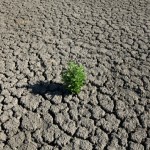How the Texas Drought Compares to the Rest of the World
With the current drought now more or less at the one-year mark and breaking records along the way, many are wondering if it will ever end. Another question is, how unique is this drought to Texas and the surrounding region?
Researchers at the University College London’s Department of Space and Climate Physics have put together an interactive global drought monitor that allows you to put the current drought into perspective.
As you can see from the map, Texas is one of the few places in the world in “extreme drought,” the highest level possible. It’s clear that the current drought in the Lone Star State is the largest, most intense one in the world:
And here are some sobering scenes from a possible future if the drought doesn’t end in the next few years:
“The year is 2020 and Texas is in its tenth year of an exceptional drought of record. Scattered along the Texas coast, large desalination plants are being built to transform salty water from the Gulf of Mexico into drinking water for a large portion of the state’s population. The norm for lawns is brown, not green; and rice farmers are starting all over with a different crop.”
That’s from the Texas Water Resources Institute, which looked at the policy implications of an ongoing drought. With an extremely dry future possible, will the state have to use more unconventional methods of finding water? Dr. Ronald Kaiser, chair of the Texas A&M University Water Program, had this to say:
“Kaiser believes the state will eventually put a greater emphasis on desalination of salty, or brackish water but the costs to do that will be high. “Texas has large supplies of brackish groundwater that can be tapped,” he said. “However that water will be expensive to develop and it may be that only cities and industry will be able to afford it.”
“The era of cheap and plentiful water is coming to an end,” he said.
Texas, however, will never run out of water. “We have a wonderful resource called the Gulf of Mexico and there is plenty of water there.”



